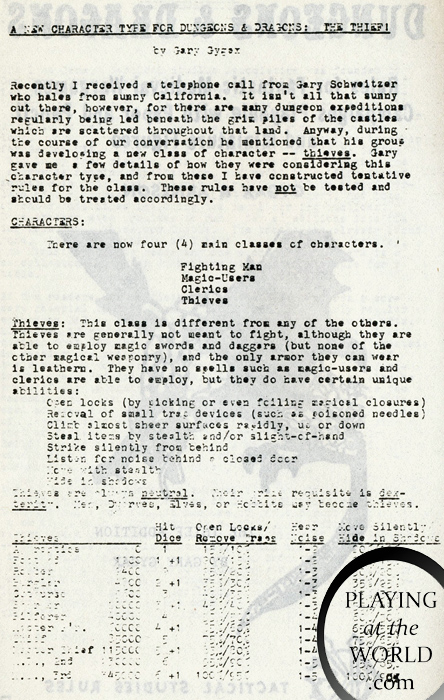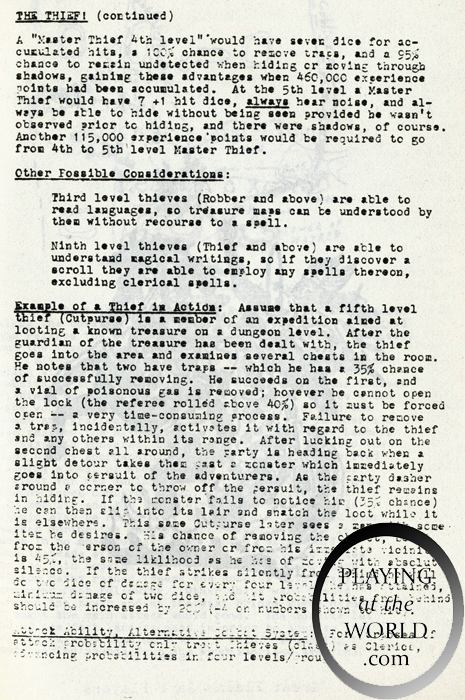A recent article and documentary about Dave Arneson's involvement in Dungeons & Dragons shares a different perspective on the game's creation, with a particular emphasis on Rob Kuntz's testimony. Some of it contradicts what Gary Gygax positioned as D&D's origins. Fortunately we can read what both designers thoughts in their very own words -- published in the same book.

Alzrius pointed out that both Arneson and Gygax contributed essays to Lawrence Schick's Heroic Worlds. What's startling is how their essays contradict each other just pages apart.
Heroic Worlds, published in 1991, was an attempt to catalog every tabletop role-playing games publication. It was a massive undertaking that was possible only because of the limited scope of the hobby. Thanks to electronic publishing, the Open Game License, and the Internet, tabletop gaming products have exploded -- DriveThruRPG has over 30,000 products alone -- making it impossible to produce a book of this scope ever again. It also provides a snapshot in time of the thoughts of various game designers, including Steve Jackon, Jennell Jaquays, Tom Moldavy, Sandy Petersen, Ken St. Andre, Michael Stackpole, Greg Stafford, Erick Wujcik and more.
Arneson kicks off the D&D controversy on page 131:
Alzrius pointed out that both Arneson and Gygax contributed essays to Lawrence Schick's Heroic Worlds. What's startling is how their essays contradict each other just pages apart.
Heroic Worlds, published in 1991, was an attempt to catalog every tabletop role-playing games publication. It was a massive undertaking that was possible only because of the limited scope of the hobby. Thanks to electronic publishing, the Open Game License, and the Internet, tabletop gaming products have exploded -- DriveThruRPG has over 30,000 products alone -- making it impossible to produce a book of this scope ever again. It also provides a snapshot in time of the thoughts of various game designers, including Steve Jackon, Jennell Jaquays, Tom Moldavy, Sandy Petersen, Ken St. Andre, Michael Stackpole, Greg Stafford, Erick Wujcik and more.
Arneson kicks off the D&D controversy on page 131:
Gygax follows up on the origins of D&D in a short one-page essay on the very next page:My first set of miniatures rules was for fighting out battles with sailing ships. This led me to meet several people, including Gary Gygax, at an early GenCon. These people later participated in a historical campaign I refereed. When I began refereeing what later became D&D in Minnesota, I mentioned it to them. They were interested, and when some of us went down to visit we all played this strange game...the lads in Lake Geneva got turned on to it. Tactical Studies Rules, a Lake Geneva-based game company, was already publishing historical rules and was willing to do D&D.
This point is disputed by RPG archivist, Paul Stromberg, in the Kotaku article, "Dungeons & Deceptions: The First D&D Players Push Back On The Legend Of Gary Gygax":In the late 1960s a club called the Lake Geneva Tactical Studies Association met weekly at my home for military/naval miniatures gaming. From this activity sprang Chainmail. The D&D game was drawn from its rules, and that is indisputable. Chainmail was the progenitor of D&D, but the child grew to excel its parent.
This perspective is shared by Arneson himself in his first essay:“People think that Blackmoor arose from Chainmail, and thus Chainmail gave rise to Dungeons & Dragons. That is not correct,” said Stormberg, the RPG historian. While Chainmail, amongst other things, was an influence on Blackmoor, Arneson’s game was “entirely new,” he said. “It’s a game entirely unlike Chainmail. It’s like saying a Rodin uses red and a Picasso uses red so they’re the same style of painting.”
Arneson's perspective on the game industry comes through in the other essays scattered throughout the book. Here's his version of how Blackmoor came about:Contrary to rumor, the players and I were all quite in control of our mental processes when D&D was designed. I also hasten to point out hat the Chainmail connection was the use of the Combat Matrix and nothing more. Find a first-edition Chainmail and compare it to a first-edition Original D&D someday and you will see that for yourself: not a hit point, character class, level, or armor class, much less any role-playing aspects in Chainmail.
Here's Arneson's thoughts on writing a scenario:I originally began with a simple dungeon and expanded it into several dungeons loosely organized as a campaign. The rules were not really an organized set, more notes on what I had earlier. Today people expect a lot more detail, coherency, organization, and story.
And finally here's what Arneson thought of the game industry:When I design a scenario, sometimes the plot or situation will come from books I read, and sometimes it just pops into my head...Changes are made, and then the work is sent off to be butchered--er, ah, edited, I mean...The original Blackmoor supplement included what was the very first published scenario. My intention was that it would serve as a guideline for other GMs to design their own. Instead, it spawn an entire "service" industry. Oh, well...
Gygax's thoughts on the subject of D&D are well-known; Arneson's less so, and Heroic Worlds is a trove of his perspective on tabletop gaming and publishing, undoubtedly informed by his legal tussles with TSR. The difference between Arenson and Gygax's approach to gaming is starkly illustrated in their essays. And yet, despite their long and sometimes antagonistic history, Gygax ends his essay on a hopeful note:My serious advice to the would-be role-playing-game author will sound cruel and heartless, and most will be offended and not listen. To would be game designers I say: seek useful employment in another field...play your own house rules with your friends and associates; it will be less painful and far more fun. (On the other hand, frankly, I wouldn't have listened to an old fogey like me.)
Did Gygax mean "we'll" instead of "he'll"? Gygax ends the essay with our only answer: Who knows?Dave Arneson and I have spoken frequently since the time we devised D&D. We don't plan to collaborate on another game, but just maybe one day he'll decide to combine talents again.






